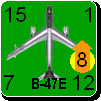Neilster
Posts: 2890
Joined: 10/27/2003
From: Hobart, Tasmania, Australia
Status: offline

|
There's a growing movement to use the Japanese nomenclature when describing their WW2 military equipment. The American nicknames are seen as less and less appropriate with time, especially as they initially selected Hillbilly names. This might be of interest...
The code name system for Japanese aircraft originated in the Southwest
Pacific theatre in the second half of 1942. Before Pearl Harbor, very
little was known about Japanese military aircraft of any type, and it was
widely assumed that most Japanese military aircraft were second-rate copies
of obsolescent Western designs. It goes without saying that the first
six months of the Pacific War showed just how wrong that view was!
The Allies were thus faced with a desperate need for accurate, up-to-date
intelligence on the Japanese aircraft which were at that time riding
roughshod over the entire Pacific theatre of operations. In June, 1942
Captain Frank T. McCoy of Nashville, Tennessee became head of the Material
Section of the Directorate of Intelligence of the allied air forces in the
entire Southwest Pacific area. His team was assigned the task of identifying
and classifying Japanese aircraft.
Since Captain McCoy was from Tennessee, he initially assigned hillbilly names
such as ZEKE, RUFE, NATE, and JAKE to Japanese aircraft--chosen so that they
were short, simple, unusual, and easy to remember. 75 code names were assigned
the first month. By September 1942, these names were in wide use throughout
the entire Southwest Pacific. Shortly thereafter, they went into use
throughout the entire Pacific.
These odd-sounding code names soon attracted attention from high-ranking
military brass. Captain McCoy assigned to what later turned out to be a
modified Zero the code name HAP, the nickname of General Henry H. ("Hap")
Arnold, USAAF Chief of Staff. The General was NOT amused, and had Capt
McCoy summoned before General MacArthur's chief of operations to explain
what he was up to. Captain McCoy seems to have gotten himself out of this
particular jam, but the name HAP was quietly changed to HAMP.
In the summer of 1944, a joint Army-Navy Air Technical Center in Washington
took over responsibility for assigning the names.
The code names were alloted according to the following system:
Male first names: Fighters and reconnaissance seaplanes
Female first names: Bombers, attack bombers, dive bombers
Reconnaissance aircraft
Flying boats
Transports (names beginning with letter T).
Tree names: Trainers
Bird names: Gliders
However, there were some exceptions to the rule. The Ki-44 Shoki single-
seat fighter was assigned the name TOJO.
Cheers, Neilster
|
 Printable Version
Printable Version




















 They will drive a player nuts in less than 5 minutes.
They will drive a player nuts in less than 5 minutes.
 New Messages
New Messages No New Messages
No New Messages Hot Topic w/ New Messages
Hot Topic w/ New Messages Hot Topic w/o New Messages
Hot Topic w/o New Messages Locked w/ New Messages
Locked w/ New Messages Locked w/o New Messages
Locked w/o New Messages Post New Thread
Post New Thread